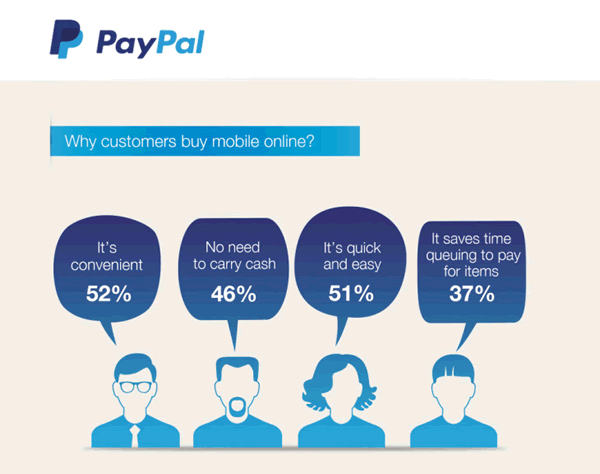Mobile devices play a key role in customer interactions and an increasing number of transactions, including commerce. The rise of mobile has been exponential in recent years and mobile impacts but also continues to drive many evolutions and trends in marketing (think about mobile content marketing or mobile email marketing), usability, user experience, the customer experience and design of customer-facing tools (responsive websites, apps,…) and really all areas of business, even leading to digital transformations.
Just think about the impact of BYOD and consumerization, mobile work or the increasing adoption of mobile by consumers in various industries and business processes.
In this blog we look at the commerce dimension of mobile and why people often refrain from using mobile forms of shopping and commercial transactions.

A survey by Webcredible looked in-depth at the behavior of smartphone users. The company found that they do not use mobile commerce (a.k.a. m-commerce) more extensively for some easy-to-solve main reasons. Note: tablets have been gradually overtaking smartphones in many regions for specific transactions but the smartphone remains important.
When focusing more on the mobile shopping experience, many of these barriers for m-commerce can be overcome. The three issues that concerned smartphone users and prevented them from using their devices to engage in m-commerce revolve around:.
- Safety and security.
- Connectivity.
- Screen size.
Security and safety concerns: consequences for m-commerce
The primary issue revolved around security. Users feared that their devices would be attacked by viruses, resulting in the theft of personal data.
People interested in e-commerce seemed to be most comfortable doing so at home. The home setting gives the buyer familiarity. The software and technology sitting on a desk at home feels secure and protective and keeps the bad guys out. That security is recognizable, and it works. On the other hand, users of mobile media haven’t yet given the thumbs up to the security featured in mobile devices.
The survey also found that smartphone users felt exposed in public, concerned about someone peaking over their shoulder as information is keyed. This is why people felt more secure buying from sites where their buying data is already stored.
Mobile commerce and the limits of small screen sizes
Users didn’t like the small screen size. The primary compliant centered around the inability to get a good look and feel for the product. Unless a buyer is familiar with a product or the product’s appearance doesn’t matter, users are hesitant to buy an item on a smartphone.
Screen sizes and the behavior of smartphone users are not taken into account enough in general, whether it concerns e-commerce, mobile websites or mobile email. Obviosuly, as devices and operating systems evolve and as retailers and other firms look at m-commerce, there are ever more possibilities to make it easy, convenient and user-friendly beyond the screen size limits. And then there is the tablet, which again offers a totally different shopping experience (and shows indeed other behavior).
The mobile user experience and the speed concern
Users also voiced concern over slow or unstable connections, fearing they would be cut off in the middle of an e-commerce transaction. This is another reason why buyers prefer buying from home.
These are matters that remain a challenge to businesses that want to sell products to buyers on mobile devices. The small screen size on smartphones will probably not be solved tomorrow but, as said, tablets become increasingly important and smartphones and apps/website possibilities change. The speed issue is also one that gets solved as we move to faster networks.
M-commerce success is about convenience, good mobile user and customer experiences and the specific behavior of smartphone users
Consumers like mobile convenience yet still want to see detail and sharp resolution before paying money. That sets up a conundrum that is difficult to solve: how do businesses offer detail on a small screen?
This is why buyers are turning to tablets to buy or going to other platforms to continue their e-commerce activities. When better taking into account the behavior of smartphone users, this can be avoided. It’s all about providing better mobile e-commerce experiences.
The matter of security and safety on mobile devices is solvable. Consumers can store purchasing data at a business they buy from. Another possibility for businesses is to offer Paypal (companies like Paypal and many others are increasingly changing the way we pay, pushing mobile and digital payments and challenging retail banks that undergo digital transformations in many areas). This eliminates the cumbersome ordeal of filling out a form on a small screen. This technique works for big e-commerce businesses like Amazon.
M-commerce is expected to soar in the coming years as the infographic by Baynote (via GetElastic) below shows. Those businesses that address these problematic issues of mobile ecommerce and better take into account the behavior of smartphone users will be invited on the mobile cruise and flourish. Businesses that ignore this issue will be set adrift on the Internet sea and be lost.
As the infographic by PayPal above shows customers buy mobile online because:
- It’s convenient
- There is no need to carry cash
- It’s quick and easy
- It saves time queuing to pay for items
Convenience and context + data and trust seems like the way to go as m-commerce continues to take off.

More findings and data from the Webcredible survey in the “mCommerce customer experience” report (PDF opens).

